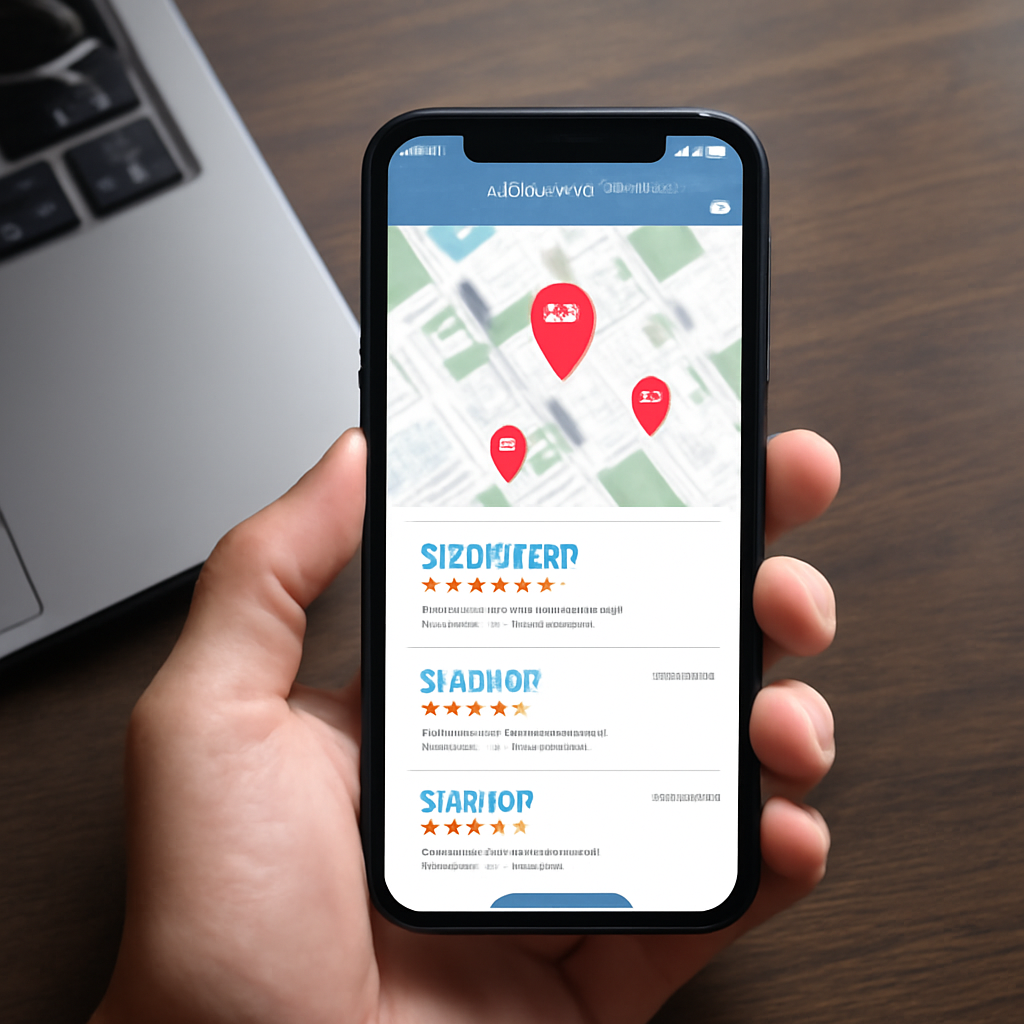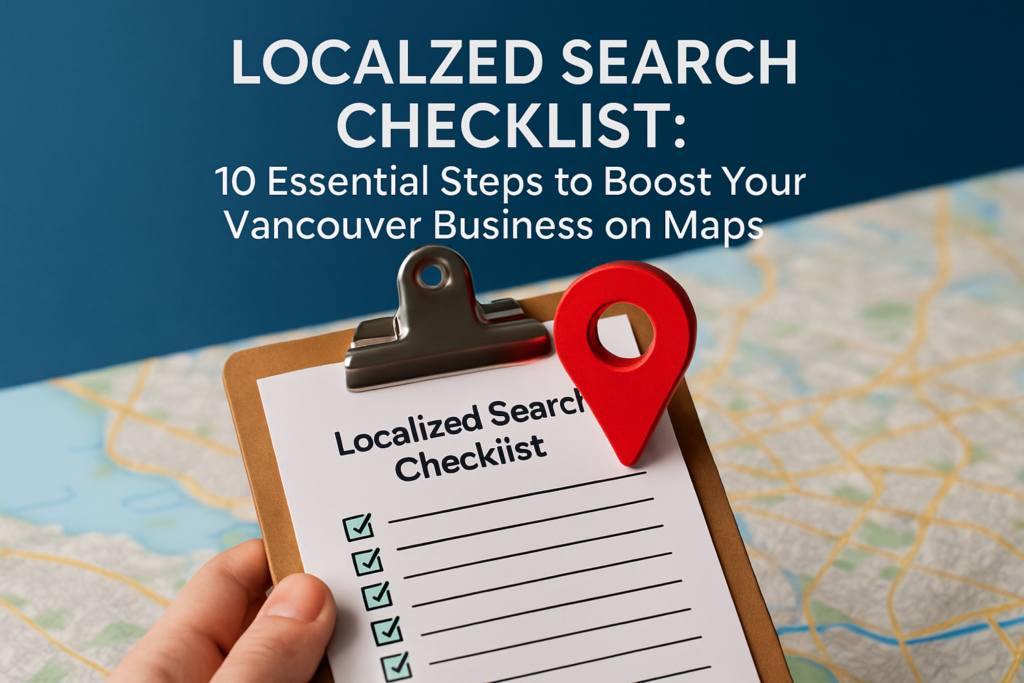If you want more walk-ins, calls, and bookings from people right here in Vancouver, you need a plan for localized search. When nearby customers search for “coffee near me” in Kitsilano or “emergency plumber” in Mount Pleasant, do you appear on Google Maps and the local pack? This guide gives you a practical, step-by-step checklist to improve visibility, attract better leads, and convert more local intent into real revenue.
You will learn what matters most for Google Business Profile, what signals help you rise above competitors, and how to track wins like calls, driving direction requests, and reviews. Along the way, you will see how Marketing VanCity powers results for small and midsize businesses with innovative marketing strategies, social media content and video support, and tailored marketing consultation that helps businesses put measurement practices in place. Ready to turn map views into customers?
Why Localized Search Matters in Vancouver
Local behavior is changing fast, and so are expectations. Industry analyses suggest that nearly half of Google queries carry local intent, and mobile searches including “near me” keep growing year over year. In a dense, neighborhood-driven city like Vancouver, that means customers are turning to Google Maps first, comparing ratings, photos, hours, and proximity before tapping to call or navigating to your door. If your profile is incomplete or inconsistent, those opportunities vanish in seconds.
Vancouver’s micro-markets make precision essential. A salon in Yaletown competes differently than a studio in Commercial Drive, and a sushi spot in Gastown faces different peak times than one along West Broadway. Because localized signals factor in relevance, distance, and prominence, even small improvements to categories, services, and reviews can nudge you above rivals. Think of localized search as the digital equivalent of the perfect storefront: clear signage, welcoming displays, and helpful staff, only now it is your profile, photos, and reviews doing the talking 24 hours a day.
Moreover, the local pack is scarce real estate, usually featuring just three listings. The jump from position four to three can be transformational, multiplying impressions and actions such as calls, website clicks, and requests for directions. With a smart plan, you can turn those micro-moments into measurable growth, and ensure every neighbourhood—from Kitsilano to Kerrisdale—can find and choose you with confidence.
Localized Search Checklist: 10 Essential Steps You Can Implement This Week
Before diving into tactics, set a clear goal. Do you want more calls, more bookings, or more foot traffic? Your goal will inform which profile fields, content formats, and customer interactions matter most. Then, commit to a weekly cadence to update photos, answer questions, and add posts; consistency sends strong freshness signals and builds trust with potential customers comparing options on their phones.
Watch This Helpful Video
To help you better understand localized search, we’ve included this informative video from Ruan M. Marinho. It provides valuable insights and visual demonstrations that complement the written content.
Use this 10-step checklist to tighten fundamentals and activate new visibility levers. Each item is designed for practicality, even if you are a team of one. As you work, think like your customers: what would you want to see before choosing a business? Accurate hours, clear pricing, authentic photos, and fast answers all reduce friction and increase conversions.
- Complete Every Field in Google Business Profile. Fill out categories, attributes, services, products, descriptions, and accessibility info. Add special hours for holidays and events to avoid mismatched expectations.
- Choose Primary and Secondary Categories Carefully. The primary category sets your core relevance. Add focused secondary categories to cover services people actually search for in Vancouver’s neighbourhoods.
- Match NAP (Name, Address, Phone) Consistency Across the Web. Ensure identical formatting on your website, citations, and social profiles. Small discrepancies can dilute trust and visibility.
- Write a Benefit-First Description With Keywords. Explain who you serve, what you do, and where you operate. Use natural synonyms and neighborhood references without keyword stuffing.
- Upload High-Quality Photos and Short Videos. Showcase exterior, interior, staff, products, and before-and-after shots. Add seasonal photos so your profile feels alive and current.
- Collect and Respond to Reviews Proactively. Ask happy customers by email and text, and reply to every review. Mention specific services in your replies to reinforce relevance.
- Publish Weekly Posts and Offers. Share announcements, events, and limited-time deals. Use clear calls to action and track clicks with UTM (Urchin Tracking Module) parameters.
- Build Local Citations and Earn Local Links. Submit to reputable directories and partner with nearby organizations. Sponsor community events to earn credible mentions.
- Answer Questions in the Q&A (Questions and Answers) Section. Seed common questions and provide helpful answers. This doubles as a mini knowledge base for busy searchers.
- Align On-Page Signals on Your Website. Create location pages with embedded maps, schema markup, and matching services. Make sure page titles, H1 headings, and content reflect local intent.
Want a snapshot of effort versus impact before you prioritize? Use the table below as a guide. While every business is unique, most Vancouver companies see the fastest wins by completing profiles, improving categories, and asking for reviews. As traction builds, posts, citations, and links compound your gains, and your Google Business Profile becomes a true local growth engine.
| Checklist Step | Time to Implement | Expected Impact | Suggested Tools |
|---|---|---|---|
| Complete profile fields | 1 to 2 hours | High, near-immediate | Google Business Profile dashboard |
| Refine categories | 30 minutes | High | Competitor scan on Google Maps |
| NAP (Name, Address, Phone) consistency | 2 to 4 hours | Medium to High | Spreadsheet, citation audit tools |
| Optimize description | 45 minutes | Medium | Keyword research, brand messaging |
| Photos and videos | 1 to 2 hours | Medium to High | Smartphone camera, basic editing |
| Reviews strategy | Ongoing | High, compounding | Email and SMS (Short Message Service) templates |
| Posts and offers | 30 minutes weekly | Medium | Posting calendar, UTM (Urchin Tracking Module) links |
| Citations and links | 2 to 6 hours monthly | Medium to High | Local directories, partnerships |
| Q&A (Questions and Answers) optimization | 20 minutes monthly | Medium | FAQ (Frequently Asked Questions) list |
| Website alignment | 2 to 8 hours | High | Content management system, schema markup |
Google Business Profile Optimization: What Great Looks Like
Think of your Google Business Profile as your strongest storefront on the busiest street in Vancouver. The most successful profiles are fully completed, visually rich, and updated weekly. They feature a clear primary category, tightly aligned secondary categories, service menus with pricing ranges, and accurate hours including holiday deviations. They show real people and real work with crisp, well-lit photos of interiors, exteriors, team members, and seasonal offerings that match the time of year in the Lower Mainland.
Great profiles also demonstrate responsiveness and community proof. They answer every review within 24 to 48 hours, using specifics from the customer’s experience. They publish helpful posts—how-tos, behind-the-scenes, and timely promotions—and include tracking with UTM (Urchin Tracking Module) parameters to measure click-through in Google Analytics. They seed the Q&A (Questions and Answers) with real questions customers ask by phone and at the counter, and they pin top answers to reduce friction for new visitors.
Finally, they connect the dots between Maps and your website. Clear on-page signals—matching NAP (Name, Address, Phone), location pages, structured data, and locally relevant content—reassure Google that your profile is accurate and helpful. This unified approach is reflected in Marketing VanCity’s engagements: through marketing consultation and content services, they guide businesses to optimize profiles, align the website, encourage reviews, and build citations. The result is a credible, consistent presence that earns trust from both customers and algorithms.
Benchmarks, Metrics, and Tools to Track Progress

You cannot improve what you do not measure. Start by defining your Key Performance Indicators (KPI) (Key Performance Indicators), then establish a baseline. For most Vancouver businesses, the essentials include: Views on Search and Maps, Actions (calls, website clicks, direction requests), Calls answered, Direction requests by neighborhood, Messages (if enabled), and Review growth and average rating. Add website metrics for local landing pages, such as organic sessions, Click Through Rate (CTR) (Click Through Rate) from local queries, and conversion rate.
Set a weekly review cadence for the first 90 days. Watch for patterns, such as spikes after posting new photos or drops when hours are out of date. Tie performance to real-world outcomes, like an uptick in lunch traffic after a weekday promotion, or more evening bookings after extending Saturday hours. Use UTM (Urchin Tracking Module) tagging to separate Google Business Profile traffic from other sources in your analytics tool, so you can attribute wins accurately and refine your efforts.
| Metric | What It Shows | Healthy Baseline | Improvement Levers |
|---|---|---|---|
| Search and Maps Views | How often your profile appears | Steady weekly growth | Categories, photos, posts, citations |
| Calls | Phone inquiries from profile | Seasonal trend with weekly consistency | Offers, hours accuracy, review velocity |
| Website Clicks | Interest in learning more | 3 to 8 percent of views; higher for services | Posts with links, compelling descriptions |
| Direction Requests | Foot traffic intent | Correlates with lunch or weekend peaks | Local posts, seasonal photos, parking info |
| Reviews and Rating | Trust and social proof | 4.5 stars or higher; steady monthly growth | Proactive asks, fast responses, service recovery |
| Click Through Rate (CTR) (Click Through Rate) | How often impressions become clicks | Improve 10 to 20 percent over 90 days | Photos, offers, accurate categories |
| Local Landing Page Conversions | Leads or bookings from local visitors | 1 to 5 percent, depending on industry | Clear calls to action, fast page speed |
Tools you can use include the Google Business Profile dashboard for core insights, Google Analytics for UTM (Urchin Tracking Module) tracking, Search Console for query visibility, and a simple spreadsheet to log updates and results. Many teams also add a monthly review meeting to connect findings to staffing, inventory, and promotional calendars. Over time, this feedback loop creates a resilient system that keeps you visible even as algorithms evolve.
Real-World Example: A Kitsilano Café Climbs the Map Pack
Consider a small café near West 4th Avenue that struggled to appear for “breakfast near me” on weekends. The owner had a basic profile with a few photos and inconsistent hours. Marketing VanCity worked with the owner to complete all profile fields, refine categories to “Breakfast restaurant” and “Cafe,” upload new photos, and add weekly posts featuring weekend specials. The team also recommended standardizing NAP (Name, Address, Phone) formatting and updating hours to reflect extended Saturday and Sunday service.
Within six weeks, discovery views on Maps rose by roughly 38 percent, calls increased by 22 percent, and direction requests on weekends nearly doubled. Review velocity improved as staff began asking for feedback at the counter and via receipt QR codes. Posts with UTM (Urchin Tracking Module) tagging revealed that breakfast specials drove a surge in website clicks between 8 and 10 a.m., prompting the café to adjust pastry production and staffing. The result was fewer stockouts, shorter lines, and happier regulars.
What changed? Clarity and consistency. With a complete profile, helpful posts, matching on-site content, and active engagement in reviews and Q&A (Questions and Answers), the café earned both algorithmic trust and human preference. That combination is the essence of localized search success in Vancouver’s competitive food scene, and the same playbook translates to salons, clinics, trades, and professional services.
How Marketing VanCity Orchestrates Sustainable Local Growth
Marketing VanCity specializes in helping Vancouver businesses overcome the visibility gap that keeps ideal customers from finding and engaging with them. The approach blends marketing consultation, social media content creation, video editing, and innovative marketing strategies. Each engagement starts with a discovery workshop, a profile and citation audit (delivered as part of consultation), and a roadmap that prioritizes actions by impact and effort, so you make measurable progress in your first month.
Execution with client teams includes refining categories and services, creating a review acquisition plan, building a monthly posting calendar, and aligning your website’s on-page elements through consultation. The team also supports neighborhood-specific content—think service pages for Kitsilano, Gastown, and Mount Pleasant—so your relevance strengthens in the areas that matter most. For businesses active on Instagram and Facebook, social content created by the team coordinates with Google posts and on-site promotions to reinforce offers and increase engagement across channels.
Importantly, Marketing VanCity helps clients establish a measurement rhythm through marketing consultation and reporting templates. You will see plain-language guidance and templates that tie Views, Calls, Website Clicks, and Direction Requests to actions taken, so there is no guessing about what worked. Over the next quarter, this creates a flywheel: consistent updates improve visibility, better visibility drives actions, and actions fuel more reviews and content ideas. That is how coordinated marketing work transforms map placement into predictable revenue.
| Service Area | Primary Activities | Typical Outcome |
|---|---|---|
| Guidance on Google Business Profile best practices (via consultation) | Categories, services, photos, posts, reviews (guidance) | Higher local pack engagement and clearer profiles |
| Marketing consultation for local visibility | Location page advice, content alignment, schema recommendations | More organic visits from nearby searchers |
| Social media content and video | Coordinated offers, community highlights, short video edits | Broader awareness and review acquisition |
| Marketing consultation and content services | Content strategy, email ideas, campaign and landing page guidance | Improved conversion rate and lifetime value |
| Measurement guidance and reporting support | Templates, insights, and action plans delivered through consultation | Continuous improvement and accountability |
Troubleshooting: Common Issues and Quick Fixes

Not seeing movement after a few weeks? Start by checking your category alignment and hours accuracy. Many businesses also forget to verify their address or to add a service area for mobile teams. If reviews are stagnant, integrate a polite ask into your post-purchase flow: printed cards, email follow-ups, and friendly reminders at pickup. When you respond, reference specific services and use a warm, human tone—customers notice.
If impressions rise but actions do not, your visuals and offers may not resonate. Add brighter photos, show people enjoying the space, and test a timely promotion. For service providers, add pricing ranges or package examples to reduce uncertainty. If calls come in after hours, consider call routing or automated texts to capture leads. Finally, audit NAP (Name, Address, Phone) consistency; a few mismatched listings can undermine trust and suppress rankings.
When in doubt, return to the checklist and update one item per week. The compounding effect of small, continuous improvements is powerful. And if you prefer a guided path, a partner like Marketing VanCity can set up your systems, coach your team, and keep the engine running with a data-backed plan tailored to Vancouver’s neighborhoods.
Resource Snapshot: What to Do Monthly vs. Quarterly
To stay organized, split tasks into monthly hygiene and quarterly deep-dives. Monthly, add fresh photos, respond to every review, publish at least one post, and verify hours. Quarterly, review categories, update services and products, refresh your description, and audit citations. For many Vancouver businesses with seasonal patterns—ski season, summer festivals, or back-to-school—these checkpoints align naturally with promotional cycles.
| Cadence | Tasks | Why It Matters |
|---|---|---|
| Monthly | Photos, posts, review replies, hours check | Freshness and engagement signals |
| Quarterly | Category and service updates, description refresh | Relevance alignment to search trends |
| Biannually | Citation audit, competitive scan, content gaps | Authority and differentiation |
| Annually | Photo shoot, brand messaging review | Quality upgrades and consistency |
Conclusion
Master the checklist, and your Vancouver business can own more moments on Maps when customers are ready to act. Imagine the next 12 months with steadier foot traffic, fuller calendars, and a review profile that sparkles because your systems make excellence routine. What would your team do with that momentum, and which step will you start today to elevate your localized search presence?
Picture your Google profile becoming the most persuasive version of your brand, always accurate, always helpful, and always visible in localized search. Which neighborhood do you want to win first?
Additional Resources
Explore these authoritative resources to dive deeper into localized search.
Elevate Localized Search Results with Marketing Vancity
By focusing on innovative marketing strategies, social media content creation, video editing, and tailored marketing consultation, Marketing VanCity helps businesses increase local visibility and attract more local customers.

